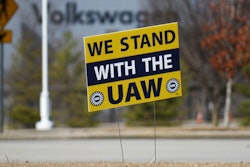
There was a time when factory jobs lifted millions U.S. workers out of poverty. But according to new data, today’s wages aren’t even enough to support the lives of 1 in 3 manufacturing employees.
The study, conducted by the University of California, Berkeley, found that about one-third of manufacturing workers seek government assistance in the form of food stamps, healthcare subsidies, tax credits for the poor or other forms of welfare to offset low wages.
This amounts to about 2 million workers, and between 2009 and 2013, the cost for assisting these workers added up to $10.2 billion per year.
What’s more, the amount of employees on assistance shoots up 50 percent when temporary workers are included. In fact, the use of temp workers, who can be paid less and offered limited benefits, is one of the main reasons why the overall wages picture looks bleak for manufacturing.
 (AP Photo)
(AP Photo)“In decades past, production workers employed in manufacturing earned wages significantly higher than the U.S. average, but by 2013 the typical manufacturing production worker made 7.7 percent below the median wage for all occupations,” said Ken Jacobs, chair of the UC Berkeley Center for Labor Research and Education, in the paper.
“The reality is the production jobs are increasingly coming to resemble fast-food or Walmart jobs,” Jacobs said.
By comparison, the number of fast-food workers who rely on public assistance is about 52 percent.
Oregon was named as the state that has the highest number of factory workers using food stamps, while Mississippi and Illinois lead the country in states needing healthcare assistance. When all forms of government subsidies were factored in, the states with the most manufacturing workers needing help were Mississippi, Georgia, California and Texas.
The research found that the median wage for non-supervisory manufacturing jobs was $15.66 in 2013, while one-fourth of the workers were making $11.91, and many more make less.
 (AP Photo)
(AP Photo)A CNBC report on the study detailed the struggles of a single mom working as an assembler at a Detroit Chassis plant in Ohio for $9.50 an hour. She often doesn’t get full 40-hour work weeks and said she has to rely on food stamps, Medicaid and other government programs.
"I absolutely hate being on public assistance," she said. "You constantly have people judging you."
The report comes as debate about the minimum wage heats up in the presidential race. Raising the federal minimum wage to $15 has been a chief platform issue for Democratic presidential hopeful, Bernie Sanders. Presumptive Republican candidate Donald Trump has also shown support for lifting wages to some degree.
The findings have also added a sour note to recent good news about jobs in the U.S. Recently, the White House was boasting about improvements in the economy and cited a government report showing that about 232,000 new positions were created during the past 12 months.






















